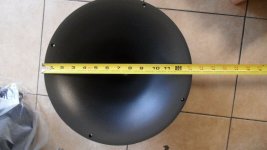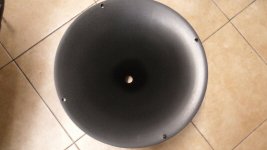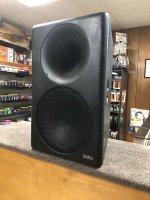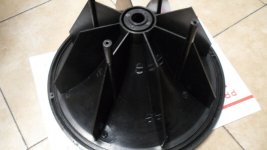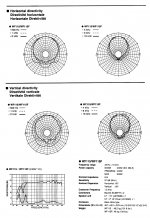Anyone who prefers a modern 1" compression driver to a 3" (or bigger) diaphragm in the 500-1000Hz range, should have his/her ears checked.
You should explain why IHMO.
268 page and still no conclusion ???
Answer was NO from the beginning. Everyhing else is about what concept is the least compromised.
Wrong Issue
1) For optimal performance, voice coil and diaphragm masses should be approximately equal.
2) The use of servo control, particularly in domestic settings, delivers performance and diminutive size advantages not otherwise available; i.e., more volume displacement [VD], at a lower frequency bound, is delivered for a given occupancy volume. Cost: more class D amplifier power. For DIY see Rythmik Audio's offerings.
Rythmik Audio • Servo subwoofer products
3) For large scale PA venues, only PowerSoft's M-Force driver is currently available to implement this technology. In a domestic setting, make shure you shoe laces are well tied and a sand box is near-by while listening to a pair of these beasts. See attached "MForce" PDF files for details.
WHG
>Snip<
It does not matter if the cone is light duty or heavy duty.
1) For optimal performance, voice coil and diaphragm masses should be approximately equal.
2) The use of servo control, particularly in domestic settings, delivers performance and diminutive size advantages not otherwise available; i.e., more volume displacement [VD], at a lower frequency bound, is delivered for a given occupancy volume. Cost: more class D amplifier power. For DIY see Rythmik Audio's offerings.
Rythmik Audio • Servo subwoofer products
3) For large scale PA venues, only PowerSoft's M-Force driver is currently available to implement this technology. In a domestic setting, make shure you shoe laces are well tied and a sand box is near-by while listening to a pair of these beasts. See attached "MForce" PDF files for details.
WHG
Attachments
Last edited:
Muddy vs Clarity
In the setting Klipsch was addressing, driver operation over a bandwidth in excess of a decade was required. This is a consequence of the imposition of a two-way loudspeaker system design regimen. It takes three channels of approximately a decade each to adequately cover the audio spectrum, assuming high quality sound reproduction is the system mission.
Signal following capability is reflected by frequency response upper bound, and drive signal conditioning. What happens when the drive signal goes to zero is most important. This is determined by [BL] product, moving mass [MMD], enclosure damping [Q], or the lack thereof, and an assumed miniscule source impedance of the power amplifier. My preference is servo-controlled, in sealed back enclosure for domestic venues. Here, some amplifier power, will be expended to maintain control over diaphragm excursion (to avoid producing sounds not contained in the driving signal). WHG
Interesting article, thank you for posting.
Admittedly, I have my doubts about modulation distortion being a major issue with the "heavy duty drivers" such as the B&C 15NBX100 & 15TBX100.
I do think the "acceleration factor" matters.
In the setting Klipsch was addressing, driver operation over a bandwidth in excess of a decade was required. This is a consequence of the imposition of a two-way loudspeaker system design regimen. It takes three channels of approximately a decade each to adequately cover the audio spectrum, assuming high quality sound reproduction is the system mission.
Signal following capability is reflected by frequency response upper bound, and drive signal conditioning. What happens when the drive signal goes to zero is most important. This is determined by [BL] product, moving mass [MMD], enclosure damping [Q], or the lack thereof, and an assumed miniscule source impedance of the power amplifier. My preference is servo-controlled, in sealed back enclosure for domestic venues. Here, some amplifier power, will be expended to maintain control over diaphragm excursion (to avoid producing sounds not contained in the driving signal). WHG
Last edited:
No arguing with that, WHG
It's somewhat utopian to try to cover 20-20k with a 2-way.
Sub/infra bass demand a separate solution.
35-20k -3dB in room is doable, if one is willing to accept a few minor compromises.
It's somewhat utopian to try to cover 20-20k with a 2-way.
Sub/infra bass demand a separate solution.
35-20k -3dB in room is doable, if one is willing to accept a few minor compromises.
Last edited:
If there was, it may be inherent to one way. I wouldn't assume Earl would ignore this in a crossover, he is too aware.screenshots of Summa polars that have rather small but obvious narrowing at 1000Hz. That wouldn't form with 700Hz - as it does not with NS15.
I don't think so.Summa was passive loudspeaker for a long time. My guess is that with DSP the crossover frequency went down.
If there was, it may be inherent to one way. I wouldn't assume Earl would ignore this in a crossover, he is too aware.
I wouldn't know really. Fact is that it is present even on polar posted by Ro808 but a little higher. It is not there with NS15.
... I don't think so.
You don't think that it was passive or that the crossover frequency went down with various updates ?
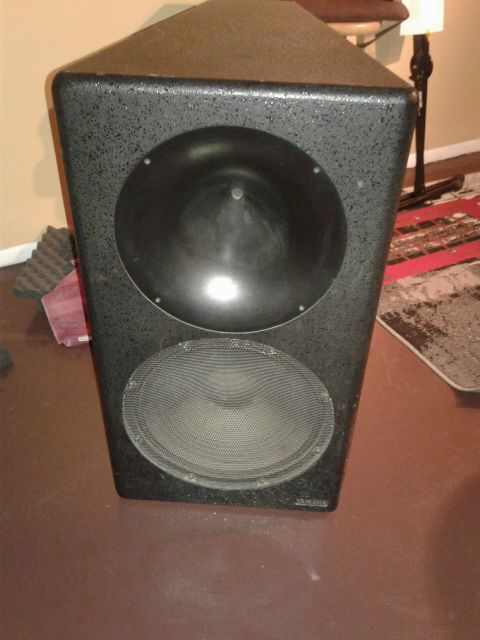
Attachments
A bunch of these horns (YAMAHA CBY02920 HORN- 60 DEGREE WF115) are currently for sale, new in box, $80 each.
It's the most interesting part of the Yamaha Waveform loudspeaker series, and apparently pretty decent.
It's a 2" horn though and way too small to be used below 1000Hz, therefore not very appealing compared to other offerings.
It's the most interesting part of the Yamaha Waveform loudspeaker series, and apparently pretty decent.
It's a 2" horn though and way too small to be used below 1000Hz, therefore not very appealing compared to other offerings.
Last edited:
Answer was NO from the beginning. Everyhing else is about what concept is the least compromised.
Tell that to these guys
M2 Master Reference Monitor Products | JBL Professional
The topic has been concluded in this sense," is it possible"....we concluded on yes many pages ago, actually, everything else has been, for me, about how I personally am going to tackle the challenge. My idea of "full spectrum" is specific to 30hz-20khz, linear, which I stated early in the thread, but there is so many pages that any one could miss it, but again its been made concrete.
.....and even though the type of product, I personally choose, is struggling to make it to 20khz, the 20khz goal was a means to an end... there are several Air motion tweeters that fit the bill. So another clarification needs to be made....Full Spectrum doesn't always equate to 20hz-20khz... if we are going to be patronizing then full spectrum is 0hz to infinity hertz....so yeah, guess it ain't gonna happen with any speakers made on earth lol! The main challenge is choosing the right woofer anyway, mid range needs to be protected from high excursion, there are 15" woofers out there (AEtd15m / Jbl2216nd/ FaitalPro15H50016ohm to name a few) that can do. I even wrote a preclude on the several configurations that allowed the goal to be accomplished (with the mention'd 15") in order of spl potential. TM 2-way, MTM or TMM 2-way, and finally, a TMM comprised of a 2 way and a sub.
I spouted off random spl goals because I was winging it. To be true to the post title....you first have to accept that most people are going to consider 100db @ 3ft "high spl" which puts all of the set ups described, in a mode of un--inhibition compared to 120db. I first said 120db because I recognized the number from m2 data. Personally I only really want to hit 116db @ 3ft which is still way louder than most people are ever going to want. I don't even plan on listening that loud.......all the time. The spl goal truly is again, a means to an end.
"Definition of a means to an end. : something done only to produce a desired result"
^This^It's somewhat utopian to try to cover 20-20k with a 2-way.
Utopian - "Having impossibly ideal conditions"
The post was purposely aimed this way in order to figure out;
what concept is the least compromised
The discussion still goes on because we are nit picking the **** out of the topic, to which I hope you join, I'm sure you have plenty of knowledge to add.
I also have not heard from AE in over a week, I hope he gets to my email before filling my order. I ordered something over 3 months ago btw, which has been a blessing in disguise since I've already made changes to my order once.
Last edited:
No arguing with that, WHG
It's somewhat utopian to try to cover 20-20k with a 2-way.
Sub/infra bass demand a separate solution.
35-20k -3dB in room is doable, if one is willing to accept a few minor compromises.
I quoted you because you actually get it

I am leaning on the wisdom of the board, btw, when it comes to this idea that above 10khz "who cares"..."only german shepards and policeman can hear it". As I so subtly assured in the beginning. This is a design intended to be a set of reference monitors which technically are studio monitors. So the idea, that musically, we can suffice with a top limit of 16khz.....has nothing to do with anything.
Reference - "the use of a source of information in order to ascertain something"
I need to be able to ascertain (find (something) out for certain; make sure of.) that what I hear on a track is what I actually am hearing and any area left un-spectulated (16khz-20khz in this example) might result in untreated issues, in the real world outside my studio.....I think this is where someone suggest that I low pass everything about 16khz then lmao! Do you guys get what I mean though? Like I dunno, maybe theres some type of harmonic information that changes the timbre of everything below 16khz, that lives above 16khz......and I can hypothisize that phase probably works in a harmonic manner, as well, so I'm pretty sure what I just suggested has a grain of truth.
Reference - "the use of a source of information in order to ascertain something"
I need to be able to ascertain (find (something) out for certain; make sure of.) that what I hear on a track is what I actually am hearing and any area left un-spectulated (16khz-20khz in this example) might result in untreated issues, in the real world outside my studio.....I think this is where someone suggest that I low pass everything about 16khz then lmao! Do you guys get what I mean though? Like I dunno, maybe theres some type of harmonic information that changes the timbre of everything below 16khz, that lives above 16khz......and I can hypothisize that phase probably works in a harmonic manner, as well, so I'm pretty sure what I just suggested has a grain of truth.
Last edited:
If you want the cleanest output, Beryllium is your friend.
However, some JBL folks have argued Be isn't necessarily preferable in the 245.. series.
For mixing & mastering it's always recommended to have a pair of near field monitors at hand, but you knew that already.
However, some JBL folks have argued Be isn't necessarily preferable in the 245.. series.
For mixing & mastering it's always recommended to have a pair of near field monitors at hand, but you knew that already.
Last edited:
Like I dunno, maybe theres some type of harmonic information that changes the timbre of everything below 16khz, that lives above 16khz......and I can hypothisize that phase probably works in a harmonic manner, as well, so I'm pretty sure what I just suggested has a grain of truth.
Thought we discussed this earlier: There's life above 20 kilohertz! A survey of musical instrument spectra to 102.4 kHz
But......what media handles much above 20 kHz?
Regardless, the lower the reproduction the wider the perceived BW and vice versa as best I can tell, so seems like the media forces us to go lower than higher and sure seems to work based on experiencing some really wide BW music, movie LFE soundtracks. I wish all my music was remastered to Blu ray.
GM
No! Not In Two.
That would be a 'choir preach' as JBL engineers are fully aware of the limitations of the M2's, two-way system design.
In a sales brochure they will not be pushing product limitations, now will they?
Below a reference level of only 90 Db., and below 40 Hz. the system performance plummets to 80db at 20 Hz. I expect in this last octave, distortion products are in excess 30% while port and diaphragm velocities are approaching an 180 phase spread where the bass driver no longer sees a decent acoustic load.
The cost of this two-way system, far exceeds the pocketbooks of most posting here; so even with its limitations, it is a financially untenable design for most audiophiles.
Also, this system was designed to meet the needs of a recording studio control room environment, not those needed for an at home listening experience, nor that for motion picture sound track editing studio where the last octave is most noticeably present.
It is relatively easy to get to a tenable system design in three channels without pressing the economic, electrical, mechanical, and acoustical envelopes to their extremes.
The answer remains: No! Not in two, as clearly demonstrated even by the example given.
It is apparent by your response, that this answer is not to your liking, even though consistent with the physics of the matter.
WHG
Tell that to these guys
M2 Master Reference Monitor Products | JBL Professional
That would be a 'choir preach' as JBL engineers are fully aware of the limitations of the M2's, two-way system design.
In a sales brochure they will not be pushing product limitations, now will they?
Below a reference level of only 90 Db., and below 40 Hz. the system performance plummets to 80db at 20 Hz. I expect in this last octave, distortion products are in excess 30% while port and diaphragm velocities are approaching an 180 phase spread where the bass driver no longer sees a decent acoustic load.
The cost of this two-way system, far exceeds the pocketbooks of most posting here; so even with its limitations, it is a financially untenable design for most audiophiles.
Also, this system was designed to meet the needs of a recording studio control room environment, not those needed for an at home listening experience, nor that for motion picture sound track editing studio where the last octave is most noticeably present.
It is relatively easy to get to a tenable system design in three channels without pressing the economic, electrical, mechanical, and acoustical envelopes to their extremes.
The answer remains: No! Not in two, as clearly demonstrated even by the example given.
It is apparent by your response, that this answer is not to your liking, even though consistent with the physics of the matter.
WHG
- Home
- Loudspeakers
- Multi-Way
- Is it possible to cover the whole spectrum, high SPL, low distortion with a 2-way?
